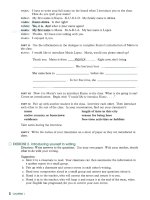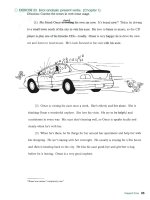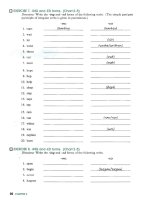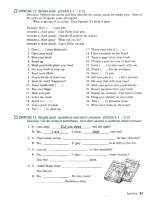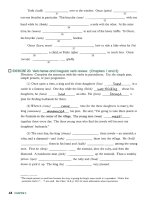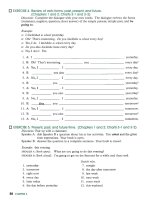Fundamentals of english grammar third edition part 3 ppsx
Bạn đang xem bản rút gọn của tài liệu. Xem và tải ngay bản đầy đủ của tài liệu tại đây (360.74 KB, 7 trang )
.
-
v.
hv+~:
I have to write your full name on the board when
I
introduce you to the class.
. ".
.,.':
How do you spell your name?
:.
.
.
KUNIO:
My first name is Kunio. K-U-N-1-0. My family name is Akiwa.
:~'
'
.
,
.C
-:?
MARIA:
Kunio Akiwa. Is that
right?
:.
I.
,.
.?
, ,
.
KUNIO:
Yes, it is. And what is your name again?"
,
'
,.<
MARIA:
My first name is Maria. M-A-R-I-A. My last name is Lopez.
.+
.
.~.
.
,.
KUNIO:
Thanks. It's been nice talking with you:
-;c:!:.
,
.
.,#.!
.
I
,
:.
.,.,
-3.;
'.jk?:
,
,'
,;
,&-,,
&:.
,.
,
.;
~6,
MARIA:
I
enjoyed it, too.
.
~,
:
PART
U.
Use the information in the dialogue to complete Kunio's introduction of Maria to
the class.
KUMO:
I would like to introduce Maria Lopez. Maria, would you please stand up?
Thank you. Maria is from
Mexkco
.
Right now, she's living
.
She has been here
She came here to
before she
.
In her free time, she
.,.:L:
PART
III.
NOW it is Maria's
turn
to introduce Kunio to the class. What is she going to say?
Create an introduction. Begin with
"I
would
like
to
introduce Kunio
.
. .
."
P~RT
IK
Pair up with another student in the class. Interview each other. Then introduce
each other to the rest of the class. In your conversation, find out your classmate's:
name
length of time
in
this
city
native country or hometown
reason for being here
residence fkee-time activities or hobbies
Take notes during the interview.
PARTK
Write the names of your classmates on a sheet of paper as they are introduced in
class.
17
EXERCISE
2.
Introducing yourself in writing.
Direcrions:
Write answers to the questions. Use your own paper. With your teacher, decide
what to do with your writing.
suggestims:
a. Give it to a classmate to read. Your classmate can then summarize the information in
a spoken report to a small group.
b. Pair up with a classmate and correct errors in each other's writing.
c. Read your composition aloud in a small group and answer any questions about it.
d. Hand it
in
to the teacher, who will correct the errors and return it to you.
e. Hand it
in
to the teacher, who will keep it and return it at the end of the term, when
your English has progressed, for you to correct your own errors.
2
CHAF'TER
1
QUESTIONS:
.
,
.
,
.
1.
What is your name?
.
.
'.
.i;.
,m
'
2.
Where are you from?
.,.
:;
''
,,
,,
.
'2
,
~
,
.
.
.~
,
,
.
:
-
,
'
"
'-,
3.
Where are you living?
4,
Why are you here (in this city)?
a. Are you a student? If so, what
are
you studying?
.
'
b. Do you work?
If
so, what is your job?
,
',
,
,
. c. Do you have another reason for being here?
!
<,
.
5.
What do you like to do in your free time?
6.
What is your favorite season of the year? Why?
7.
What are your three favorite books? Why do you like them?
8.
Describe your first day in this class.
EXERCISE
3.
Pretest (error analysis): present verbs. (Charts
1-1
-
1-6)
Directions:
All
the sentences contain mistakes. Find and correct the mistakes.
Example:
I
no like cold weather.
+
I
don't like cold weather.
1.
Student at this school.
2.
I
no living at home right now.
3.
I
be living
in
this
city.
>
:~,
,
>g7.
.
;;.
1
;
,:.
'
z
!
#
;
.
,
:
.
,.
.
.
.
,
&,
::f*
.
,
i
1
'q;,
,
.
:
i
.
>.
;,
'
.
,
'
-
.
.
.
.:
'
*.
.
1.
%%&
.;w*:g
.;::;&
;;.
, :
.:,:;.
;*
5.
I
am
not knowing my teacher's name.
6.
(supply
name)
teach our English class.
7.
Sheme* expect us to be in class on time.
8.
We always are coming to class on time.
9.
Omar does he going to school?
10.
Tom no go to school.
11.
My sister don't have a job.
12.
Does Anna has a job?
Y
I.,.<
*Choose
rhe
appmpriate
pronoun
for
your
teacher,
ha
or
$he.
Present
Time
3
1-1
THE SIMPLE PRESENT
AND
THE PRESENT
PROGRESSIVE
THE SIMPLE PRESENT
THE
PRESENT PROGRESSIVE
(a)
Ann
takes
a shower
every day.
(b)
I
usually
read
the newspaper in
the morning.
(c) Babies
my.
Birds&.
(d)
NEGATIVE:
It
doesn't snow
in Bangkok.
(e)
QUESTION:
Doe8
the teacher
speak
slowly?
(f)
Ann
can't come to the phone
right
now
because she
is taking
a
shower.
(g)
I
am reading
my grammar book
right
now.
@)
Jimmy and Susie are babies. They
are crying.
I
can hear them
right
now.
Maybe they are hungry.
(i)
NEGATIVE:
It
isn't
snowing
right now.
(j)
QUESTION:
Is
the teacher
speaking
right now?
The
SIMPLE
PIWENT
expresses
daily habits
or
usual activities,
as
in (a) and
@).
The simple present expresses
general statements offact,
as in (c).
In sum, the simple present is
used for evenrs or situations that
exist always, usually, or
habimally in the past, present,
and future.
The
PRESENT
PROGRESS~TE
expresses
an actiw'y that is in
pmgress (is occurring,
is
happenink) right now.
The event
is in progress at the time the
speaker is saying the sentence.
The event began
in
the past, is
in progress now, and
will
probably continue into the
future.
FORM:
am, is, are
+
-ing.
1-2
FORMS OF THE SIMPLE PRESENT
AND
THE PRESENT
PROGRESSIVE
I
NEGATIVE
I-You-We-They
do not work.
He-She-It
does not work.
STATEMENT
QUESTION
I-you-we-they
work?
he-she-it
work?
I
am
not working.
You-We-They
are not working.
He-She-It
is not working.
SIMPLB
PRESENT
I-You-We-They
work.
He-She-It
works.
Am
I
working?
Are
you-we-they
working?
Is
he-she-it
working?
PRESENT PROGRESSIVE
I
am working.
You-We-They
are working.
He-She-It
is working.
CONTRACTIONS
I
+
am
=
Pmworking.
you,
we,
they
+
are
=
hu're,
W're, They're
working.
he, she, it
+
is
=
He's,
She's, It's
working.
I
does
+
not
=
doesn't
She
doesn't
work.
do
+
not
=
don't
I
don't
work.
is
+
not
=
isn't
He
isn't
working.
are
+
not
=
aren't
They
aren't
working.
(am
+
not
=
am not*
I
am not working.)
Wore:
am
and
not
m
not
conmctcd.
4
CHAPTER
I
EXERCISE
4.
Slmple present
vs.
present progressive. (Charts 1-1 and 1-2)
Directions:
Discuss the verbs
in
italics.
Is the activity of the verb
(a) a daily or usual habit?
OR
(b)
happening right now (i.e., in progress in the picture)?
It's
7:30
A.M.,
and the Wilsons are in their kitchen. Mrs. Wilson
is
sitting
at the
1
breawast table. She
is reading
a
newspaper. She
reads
the newspaper every morning. Mr.
2
3
Wilson
is
pouring
a cup of coffee. He
drinks
two cups of coffee every morning before he
4
5
goes
to work. There is a cartoon onTV, but the children
aren't watching
it. They
6
7
are playing
with their toys instead. They usually
watch
cartoons in the morning, but this
8
9
morning they
aren't paying
any attention to the
TV.
Mr. and Mrs. Wilson
aren't watching
10 11
.r
-~
,.,
L;?<
~-,
'
thew either. They often
watch
the news in the evening, but they
don't watch
cartoons.
.
.!I
L
12
13
EXERCISE
5.
Slmple present
vs.
present
progressive.
(Charts 1-1 and 1-2)
Directions:
Complete the sentences by using the words in parentheses. Use the simple
EJ
;
present or the present progressive.
'.~/
1.
Shhh. The baby
(deep)
is
slee~ihs
.
The baby
(sleep)
sleeps
for ten hours every night.
Present
Time
5
2.
Right now I'm
in
class. I
at my desk.
I
usually
(sit)
at the same desk in class every day.
3.
Ali
(speak)
Arabic. Arabic is his native language, but
right now he
(speak)
English.
4.
A:
(it, rain)
a lot
in
southern California?
B: No. The weather
@e)
usually warm and sunny.
5.
A:
Look out the window.
(it,
rain)
?
Should I take
my umbrella?
B: It
(start)
to sprinkle.
6.
A:
Look. It'sYoussef.
B: Where?
+.,
<
'
,
.
.
'
_
.
'
A:
Over there. He
(walk)
out of the bakery.
7.
A: Oscar usually
(walk)
to work.
(walk,you)
-
,,.,
.<.
to work every day, too?
.
B:
Yes.
.
.
.
A:
(Oscar, walk)
with you?
B:
Sometimes.
8.
A:
Flowers! Flowers for sale!
Yes sir! Can I help you?
,
,
,
V.G.
n
.
B:
I'll
take those-the yellow ones.
I
I
., ~
,.~,
A:
Here you are, mister. Are they
for a special occasion?
B:
I
(bud
them for my wife.
I
(buy)
her flowers on the first day of every month.
6
CHAPTER
1
EXERCISE
6.
Activity: uslng the present progressive. (Charts
1-1
and
1-2)
Directions:
Student A performs an action. Student
B
describes the action, using Student
A's name and the present progressive.
Example:
stand next to your desk
TEACHER:
(Maria), would you please stand next to your desk? Thank you.
STUDENT
A:
(Student
A
stands up.)
TEACHER:
Who is standing next to her desk?
OR
What is (Maria) doing?
STUDENT
B:
(Maria) is standing next to
her
desk.
1.
stand up
12. kick your desk (softly)
2. smile
3.
whistle
4.
open or close the door
5.
hum
13. knock on the door
14.
sit on the floor
15.
shake hands with someone
16. look at your watch
6.
bite your fingernails 17. count aloud the number of people in the
room
,
7.
read your grammar book
I
18. shake your head "no"
'L,
8. erase the board
19. scratch your head
9. look at the ceiling
4
,%
20.
Perform any action you choose. Use
10.
hold your pen in your left hand objects
in
the classroom if you wish.
:i.
1 1.
rub your palms together
,.
,&
,iFi
\
.!
EXERCISE
7.
Activity: using the present progressive. (Charts
1-1
and
1-2)
Direceions:
Use the present progressive to discuss your classmates' immediate activities.
Divide into two groups,
I
and
11.
.
.
.
,
.
:
GROUPI.
DO anything you each feel like doing (stand up, talk, look out the window, etc.).
You may wish to do some interesting or slightly unusual
things.
Perform these activities at
the same time.
GROUP
XI.
Describe the immediate activities of the students in Group
I
(e.g.,
Ali
is
talking
to
Ricardo.
Yoko
ti
scratching
her
chin.
Spyros
is
leaning against
the
wall.).
Be sure to use
your classmates' names.
Later, Group
I
and Group
I1
should reverse roles, with Group
U
acting and Group
I
describing.
[7
EXERCISE
8.
Activity: using
the
present
progressive.
(Charts
1-1
and
1-2)
Directions:
Use the present progressive to describe activities in progress. Work in groups or
as a class.
FIRST:
One member of the group pretends to do something, and the rest of the
group tries to guess what the action is and describe it, using the present
progressive.
Example:
painting a wall
STUDENT
A:
(pretends
to
be painting a
wdI)
OTHERS:
You're conducting an orchestra. (No.)
Are you washing a window? (No.)
You're painting a wall. (Yes!)
SECOND:
Student
A
repeats the performance and describes hisiher actions aloud.
Example:
STUDENT
A:
I am standing in front of an unpainted wall. I'm opening a can of paint. Now
'
I,
I'm picking up
a
paintbrush. I'm dipping the brush in the can of paint. I'm
lifting the brush. Now I'm painting the wall.
Suggestions for actions:
painting a wall
drinking a cup of tealcoffee
petting a dog
dialing a telephone
climbing a tree
playing the piano
diving into a pool and swimming
driving a car
watching a tennis match
pitching a baseball
8
CHAPTER
1


